Running related injuries are at an all-time high because of shoes!
With injury plaguing our most primal form of locomotion, let’s see if the scientific literature can explain why.
From an evolutionary standpoint, we are built to run and have done so for thousands of years [1]. Traveling long distances while using the least amount of energy and staying injury free was crucial to the survival of our species. So if these traits are innate, then why do 19.4- 79.3% of recreational runners end up injured within one year of running [9]?
From a biomechanical standpoint, the most efficient movement is also the most preserving on its structures. So let’s dissect the way people run and see if any inefficiencies exist.
It is pointless to describe the running motion, as, everyone should have a pretty clear image in their heads. Let’s, however, hone in on the stage where the foot comes into contact with the ground. This part of the gait cycle has the highest forces acting on runner’s physical tissues and thus holds significance in the investigation.
There are three ways that the foot comes into contact with the ground.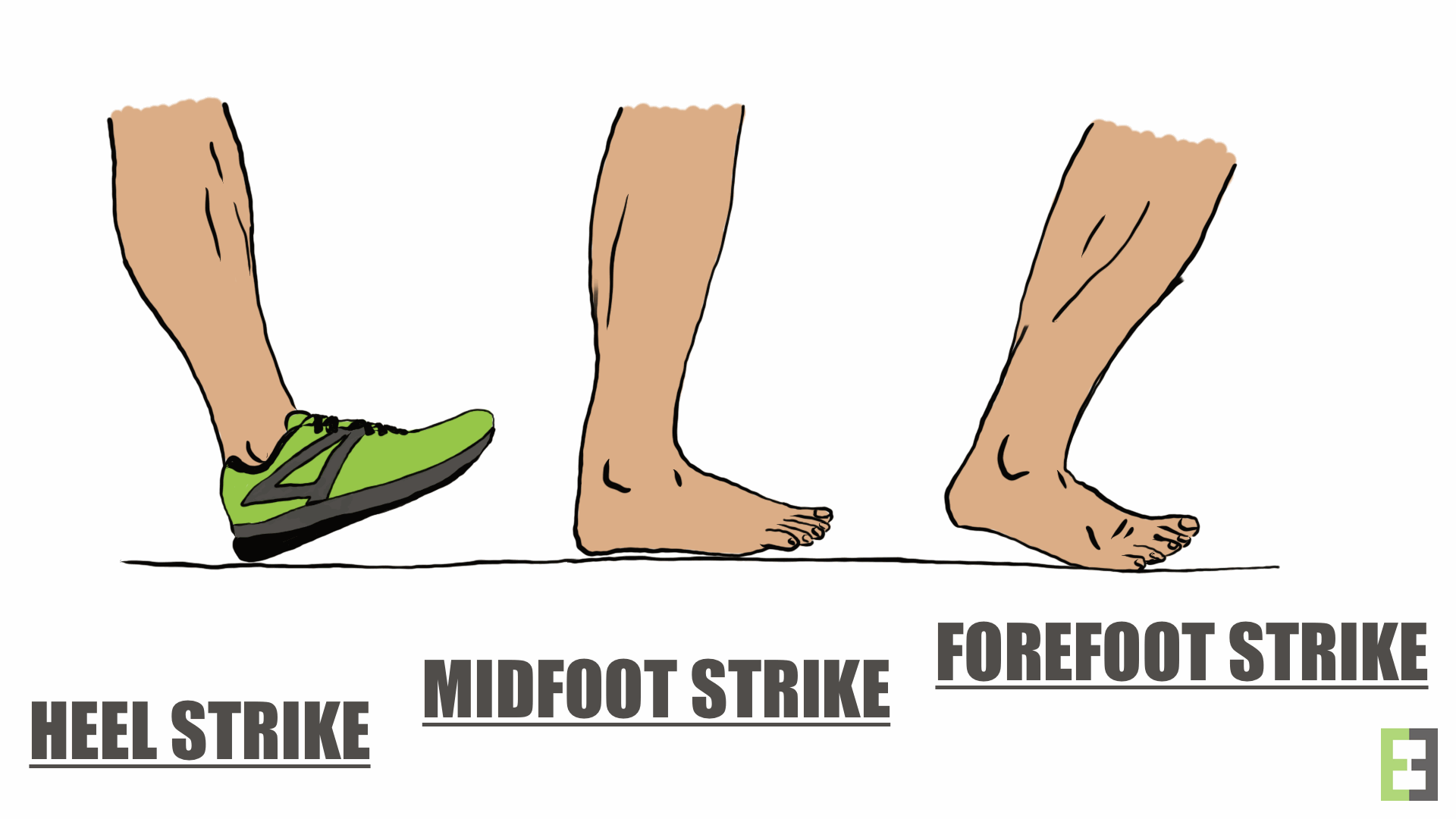
Heel/Rearfoot Strike (RFS): Heel comes in contact with the ground first at impact.
Mid-foot Strike (MFS): Middle foot comes in contact with the ground first at impact.
Forefoot Strike (FFS): Front foot makes contact with the ground first at impact.
A whopping 72-89% of runners RFS [7].
The human being has evolved to strike the ground with their mid-foot or front-foot [1]. The catalyst for high rates of heel striking is modern footwear [2][8].
Think about landing on your heels barefoot. You would feel an immediate pain shoot through your legs and into your back. The signals come from our sensory feedback mechanism which prompts us to change our movement pattern [8].
During a 12 week study, participants had to implement an increasing amount of barefoot running into their weekly training. The results showed a 90% change in running style, favoring a more forward foot strike.[6][4]
Let’s analyze the biomechanics of Barefoot running compared to shod (shoe running) and see if we can identify mechanisms for injury.
Step/Stride length and cadence
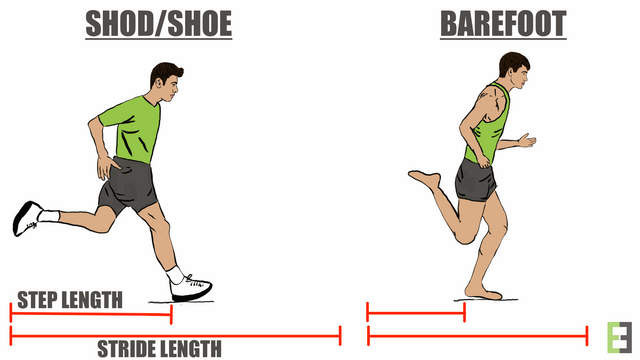
Step length: Distance between ground contact of the opposite legs
Stride length: Distance between ground contact of the same legs [5].
Efficiency
Running barefoot shortens both the step and stride lengths, which in turn increases cadence [2]. A higher cadence rate is said to conserve forward momentum [2]. This energy efficiency makes sense when we analyze foot position in relation to the center of gravity.
Centre of gravity, braking forces and Stance time
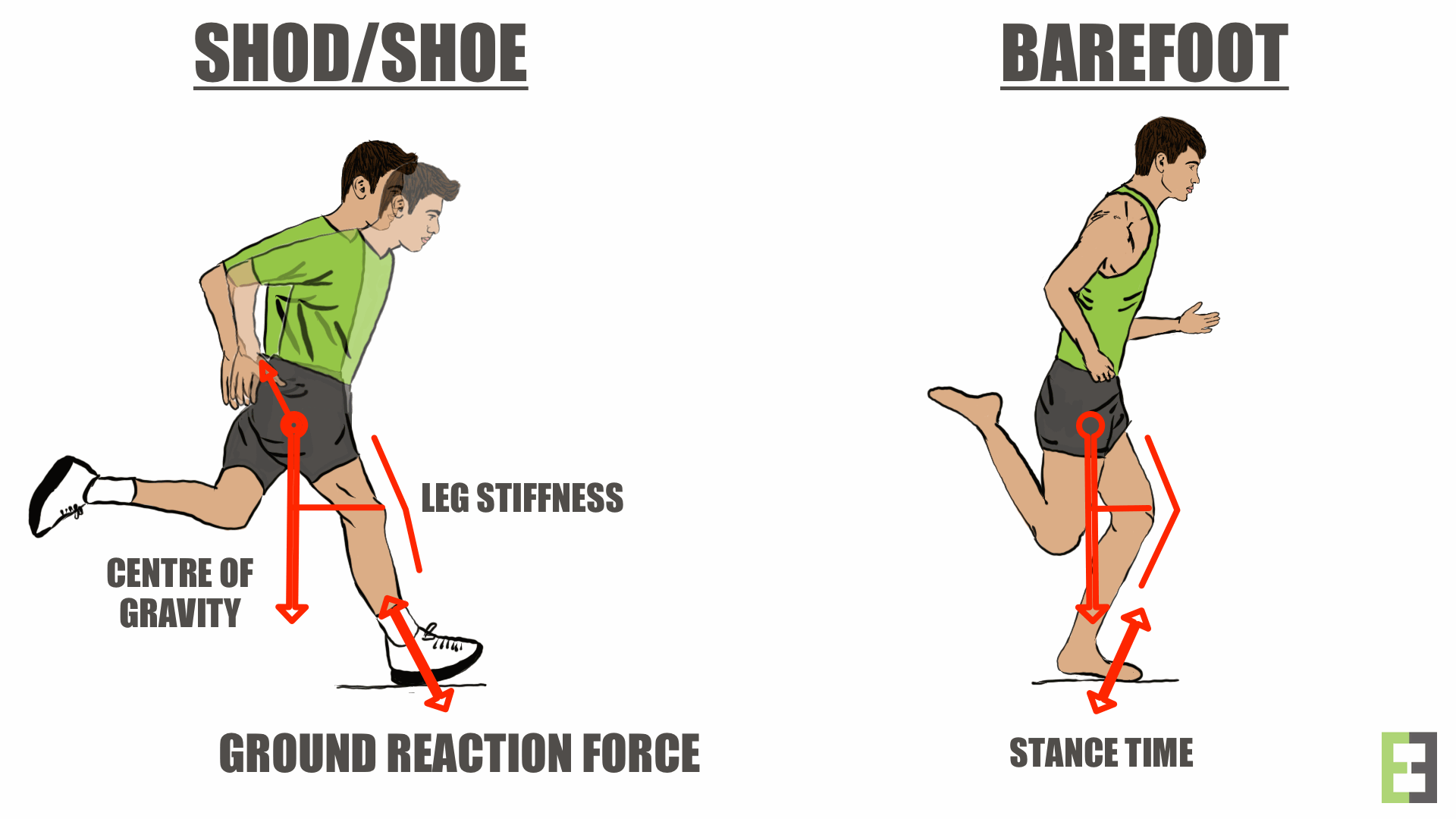
Ground reaction force (GRF): The force exerted by the earth on the body at contact [13]
Leg stiffness: The level of resistance in the leg at impact [4]
Stance time: The duration from initial contact to lift off of the foot [5]
Impulse: Force x Time
Efficiency
In this illustration, you can see the result of a lengthened stride length. The shod runner’s striking leg is so far ahead of his center of mass that he applies braking forces every time he lands.
The ground reaction forces imparted on heel strikers is up to 3x times higher than a M/FFS [6]. The high forces travel up the stance leg, into the hip and cause flexion (as seen by the torso moving forward). This upstream movement causes the runner’s center of mass to shift even further back and slow him down more [8].
Injury
Shoe runners have an increased stance time compared to BF [4]. The extra time that the foot spends in contact with the ground increases the impulse which results in higher Peak GRF in the knee joint. The runner's feet should feel the high forces and try to disperse them through a relaxed leg. Unfortunately, the use of cushioned shoes curb that sensory feedback mechanism, and the athlete ends up stiffening the leg more [4]. It is the combination of high muscle contractile forces and high ground forces that can overload the knee joint and potentially cause injury [11].
Dorsiflexion and Plantar flexion
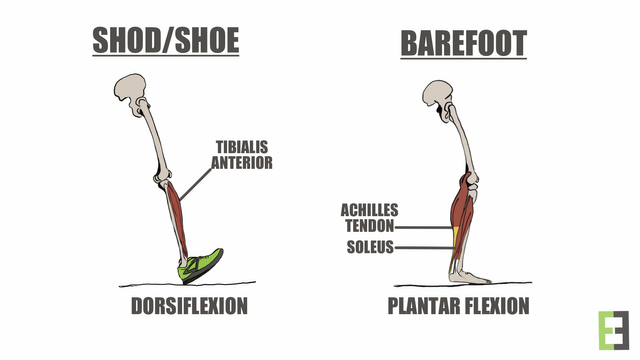
Dorsiflexion: Toes move toward shin bone
Plantar flexion: Toes move away from shin bone
Efficiency
The shod runner strikes the ground with a dorsiflexed foot position, utilizing the anterior (front) muscles of the shin bone. The barefoot runner hits the ground in a plantar flexed foot position which engages the posterior (back) tendon and muscles. The Achilles is the strongest tendon in the human body, which helps propel the athlete using its high stretch reflex capability [3]. You could think of this connective tissue as a spring. Connected to the Achilles tendon is the Soleus muscle, made up of slow twitch muscle fibers. The properties of this muscle make it very enduring and resistant to fatigue [3].
Injury
Dr. John Anderson, a physiology researcher, explained how the extra stress on the Tibialis anterior muscles of the shod runner is one of the leading contributors to shin splints today [14]. Similar statements were made in the Journal of Gait and Posture [7]. Through observation of the illustration above, it is clear that the sheer size of the posterior structures makes them more capable of handling the forces of impact.
Pronation and Knee Valgus
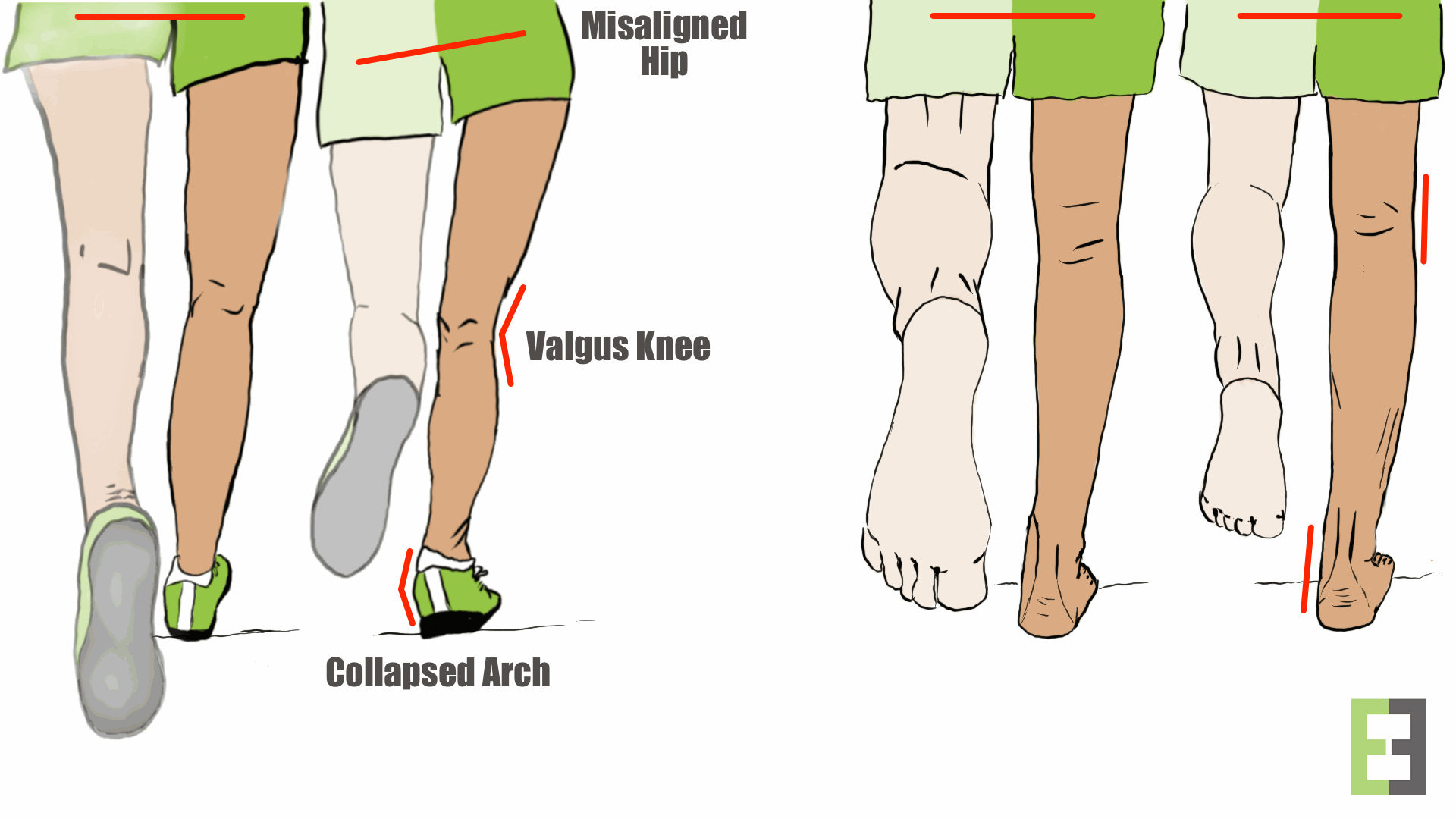
Pronation- Rolling of the foot from lateral (out) to medial (in).
Knee Valgus- Knee moves towards the midline.
Efficiency
Through the adoption of a MFS/FFS patterns of barefoot runners, the underfoot muscles are engaged to exert more thrust force through a recoil action [15]. Recruitment of these muscles happen via the enhanced sensory feedback mechanism (the ability to feel the ground at impact) [8]. On the contrary, shod runners lose this benefit because of their lack of feeling.
Injury
The use of shoes and arch support, while running, weaken the stabilizing muscles of the foot [15]. An unstable foot coupled with higher peak GRF, the shod runner excessively pronates during impact and liftoff. The model on the right shows how dormant short springs (representing the fast reacting muscles of the foot) render it helpless in the stabilisation of the ankle during high impact phases of running [1].
Excessive pronation loads the tissues of the ankle joints and collapses the arch as seen in the illustration above. Collapsing of the arch has been found to be a mechanism for plantar fasciitis syndrome. The effects move upstream by rotating the shinbone, forcing the knee joint medially (towards the midline) into a valgus position. The internal rotation has a further impact on the hip, pulling it out of alignment. This cascade of events explains the many ACL tears and lumbar injuries in so many runners [11] [16] [9].
Conclusion
Since the advent of running shoes in the 1970’s and their many technological advancements since then, it is clear that we have benefited very little from them [11]. Even though the shoe companies may not have had the intention of hurting millions of people, they have ended up doing so by changing the way people run [10].
Don’t try to fix something that is not broken. Divine creation/millions of years of evolution have equipped us with all the robust structures needed for basic locomotion. We don’t need your $150 pair of kicks.
It is not a coincidence that the Kenyan runners of the Rift Valley province, famous for their endurance running, grew up barefoot [11].
[2]https://link.springer.com/article/10.1007/s11332-017-0380-7
[3]https://www.researchgate.net/publication/7818818_The_Anatomy_of_the_Achilles_Tendon
[4]http://www.sciencedirect.com/science/article/pii/S2095254614000313
[5]http://www.apostherapy.co.uk/en/blog/spatio-temporal-parameters
[6]http://www.sciencedirect.com/science/article/pii/S2095254616000053
[7]https://www.sciencedirect.com/science/article/pii/S0966636215000715
[8]https://www.ncbi.nlm.nih.gov/pubmed/28728130
[10]http://www.sciencedirect.com/science/article/pii/S0949328X16300023
[11]https://www.nature.com/articles/nature08723
[12]https://runninginsystems.com/tag/moment-arm/
[13]https://posemethod.com/ground-reaction-force/
[14]https://hubpages.com/sports/Landing-Heel-First-when-Running-Doubles-Stress-Injury-Rates-Shin-Splints-Foot-Pain
[15]http://www.sciencedirect.com/science/article/pii/S2095254614000374
[16]https://bretcontreras.com/knee-valgus-valgus-collapse-glute-medius-strengthening-band-hip-abduction-exercises-and-ankle-dorsiflexion-drills/
If you liked this post, please follow me @exercisinghealth

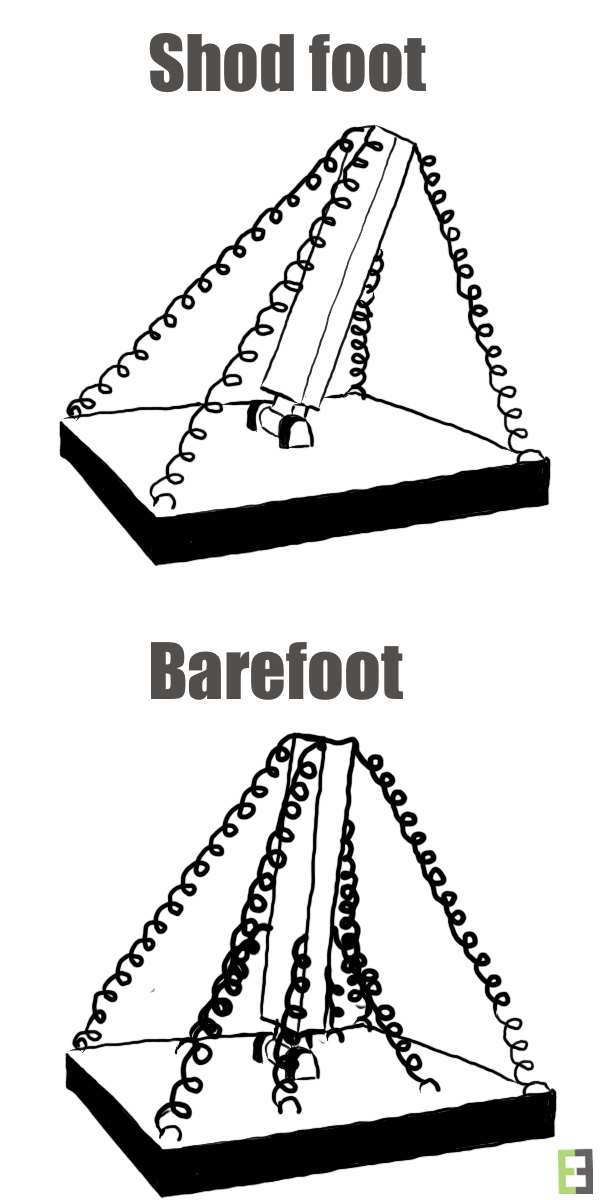
I an very underpronated so I know about pronation but this is great insight because I never thought of how different my stride is with and without shoes. I'll work on midfoot strike
Thanks for your comment. 2D video analysis can go a really long way in figuring out your patterns. If you have a mobile phone which can film slow-motion (all the new iPhones from 6 onwards), then you can record yourself running. Run on a treadmill for ease of use.
Run with and without shoes to compare differences. Make sure to run a few minutes to familiarise first.
Then practice barefoot for a few weeks, slowly increasing your volume. Film again and compare from weeks prior. I think this experiment could be really insightful.
I would love to hear about your results.
Superb article!
I've been doing running with barefoot shoes for years now, very unfrequently though, until recently when I've stepped up my running.
Now having figured out the fore foot strike technique properly the running feels amazing! The running is so effortless with a sense of flow.
But the strenghtening of muscles (responsible for plantar flexion like in your picture) really take some time to develop the endurance; starting from only a few kilometers I'm now able to run little under 15 kilometers with a complete recovery under a week. Next goal is to build up to a half marathon which is not that far away anymore!
Thank you! I'm glad you found it interesting.
I have also started running barefoot. My Achilles tendon and calves get fired up quickly at the moment. I am slowly increasing the volume over the weeks though. New movement patterns take time for the body to adapt to. You seem to be on the right track.
If you want to learn more about mid-fore foot running, I recommend a book by Dr. Nicholas Romanov called 'Running revolution'. He explains, in simple terms, how you can utilise gravity to assist you in the running. I can promise that your running will go to another level with his book.
Cool! I'll take a look of your recommendation.
Keep in touch. I'm interested to hear it you find his methods useful.
Excellent article! I love my minimal Merrell shoes for running. When I started running I had IT band issues, but after changing my footwear, doing more mobility work and foam rolling, and incorporating a lot more 1-leg exercises for stability and strength I haven't had any issues. People are always surprised that I run half marathons in the shoes that I do, but they work for me so I'm sticking to it. :)
So many people are discovering the benefits of minimal footwear for running. There is a learning curve though. Even though we can run with minimal support, the structures need time to strengthen after being dormant for so long. It is thus advisable to slowly increase your time in minimal footwear.
Out of interest, how long did it take for you to run a 21km in minimalist shoes comfortably?
Oh it does absolutely take time to build up to that distance. I think the first time I ran in minimal shoes I went less than 5k. It felt so light and free, but also strange to actually have that range of motion through my feet. I was very sore in my calves for a number of days after, so I made sure to start with only shorter distances and only a few times per week. I think I had been running 5k and 10k races in them for about a year before I started training for the longer distance. And I still only do maybe one or two longer races a year, so my weekly mileage is not as great as some people.
I really think you have gone about it in the correct manner. Hence your success. Thank you for sharing your story and I wish you many injury free miles.
I agree with you
The research for this blog has opened my eyes on this subject. I was ignorant to the effects of shoes on our health. I guess things that are so common we don't think about twice.
You totally made me look at running shoes in a different way. I thought that they were supposed to support the weight and absorb vibrations to enhance performance and protect from injuries (basically, all these things ads promise)
Yea it’s unbelievable. Most of the designers are only worried about the aesthetics. I wonder if the big shoe manufacturers are aware of the literature? At least we have brands like vibram, vivo-barefoot, merrel, among others, who are pushing minimalist shoes. Even the good old converse all-stars are a better choice than the new trainers....
σανδαλί με string, όλα τα άλλα είναι βλακείες!
I used to think that flip flops are the way to go too. But Dr. Kelly Starret, a well know physical therapist, thinks otherwise. Here is what he has to say:
https://www.mobilitywod.com/propreview/athletes-dont-wear-flip-flops-episode-219/
This post was resteemed & upvoted by @superbot - the Best Resteem bot on Planet !
Good Luck!
Follow for 10 minutes ,
Send 0.100 Steem/Steem Dollar and the URL in the memo that you want resteemed and upvoted.
So don't waste any time ! Get More Followers and gain more Visibility With Superbot .